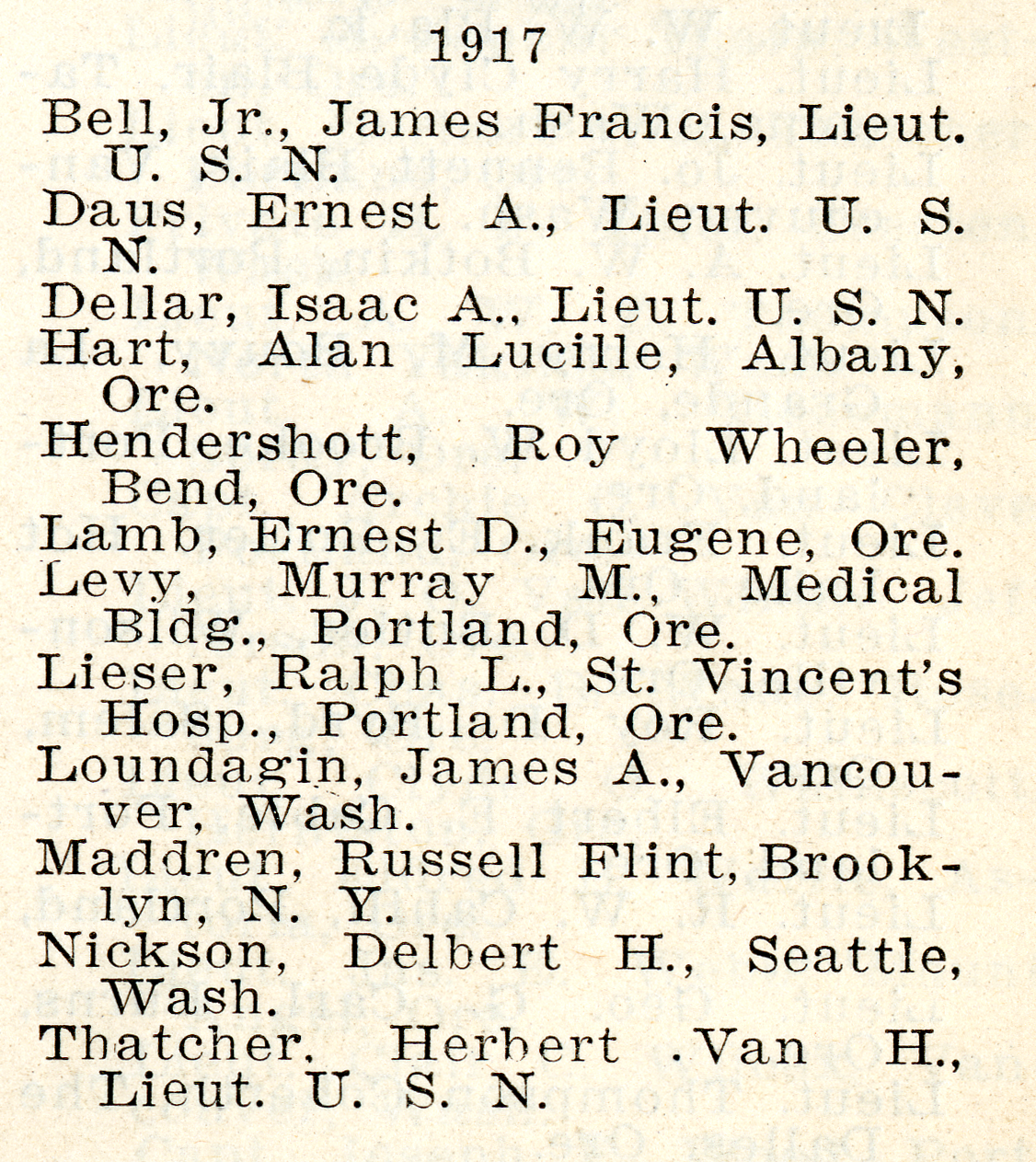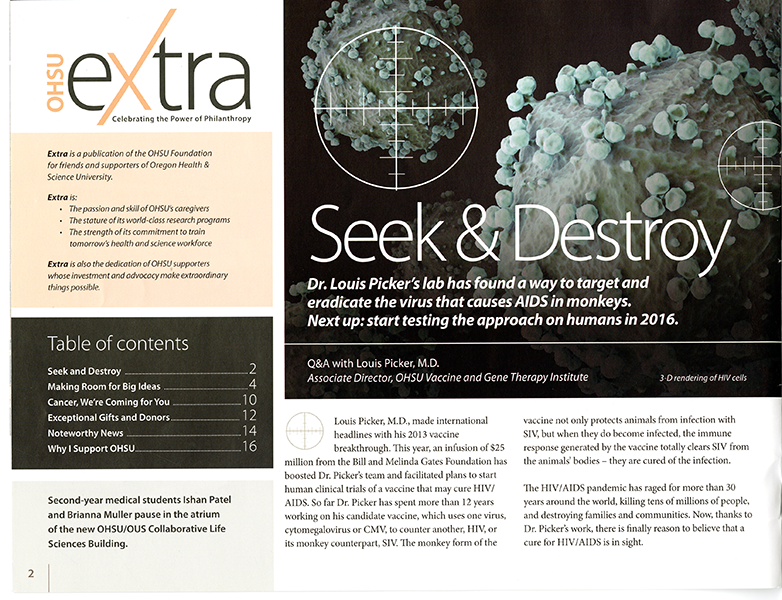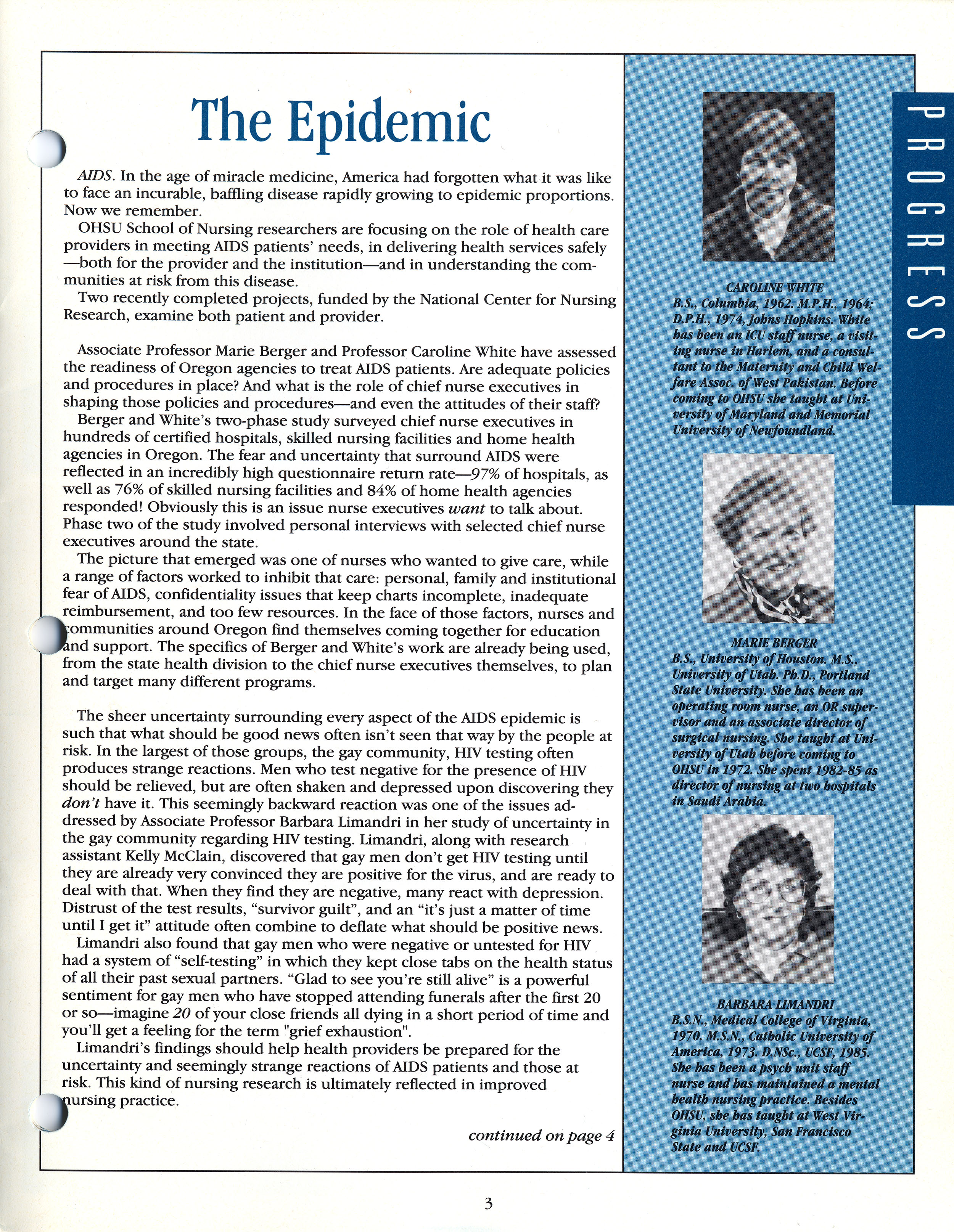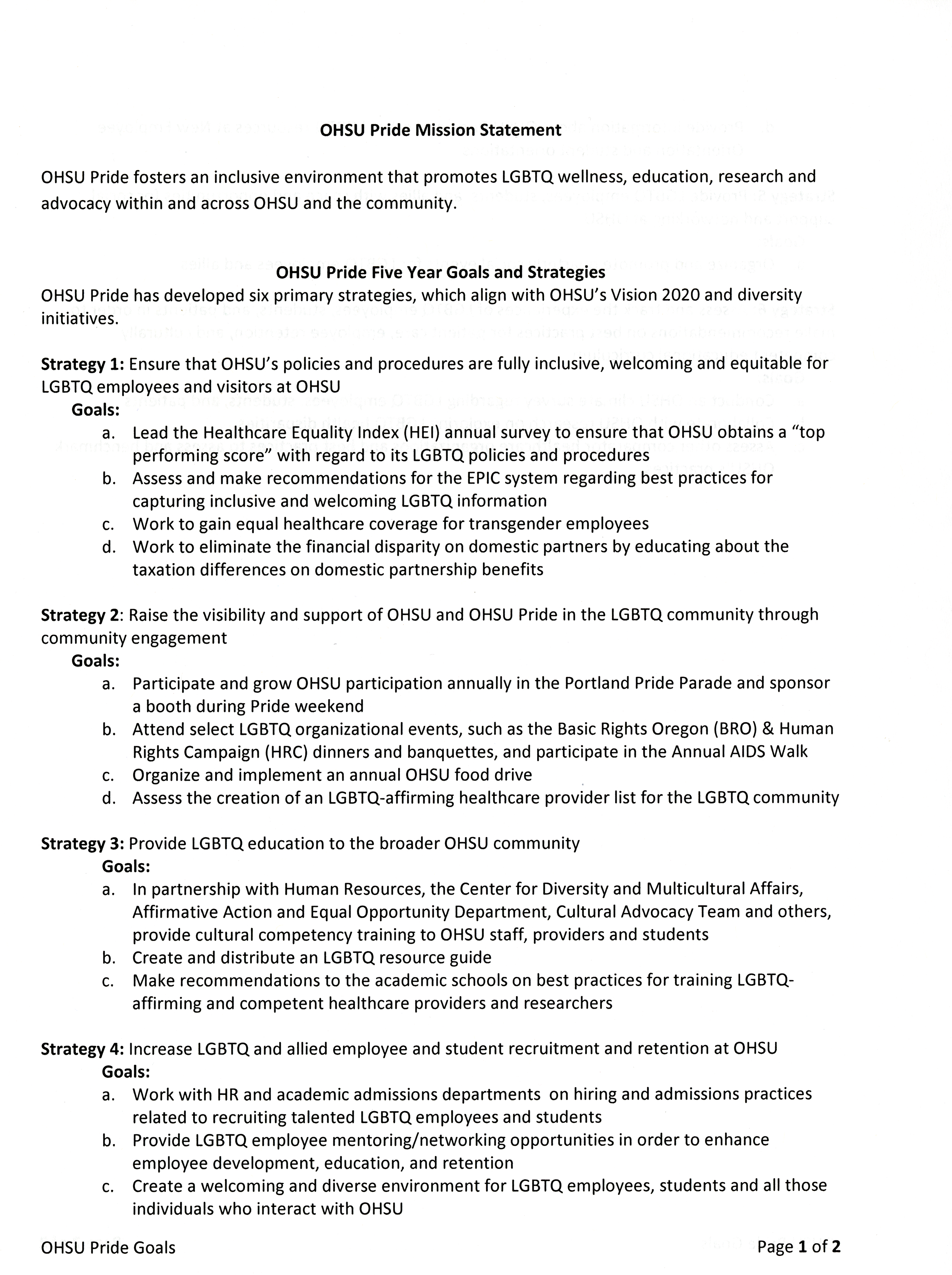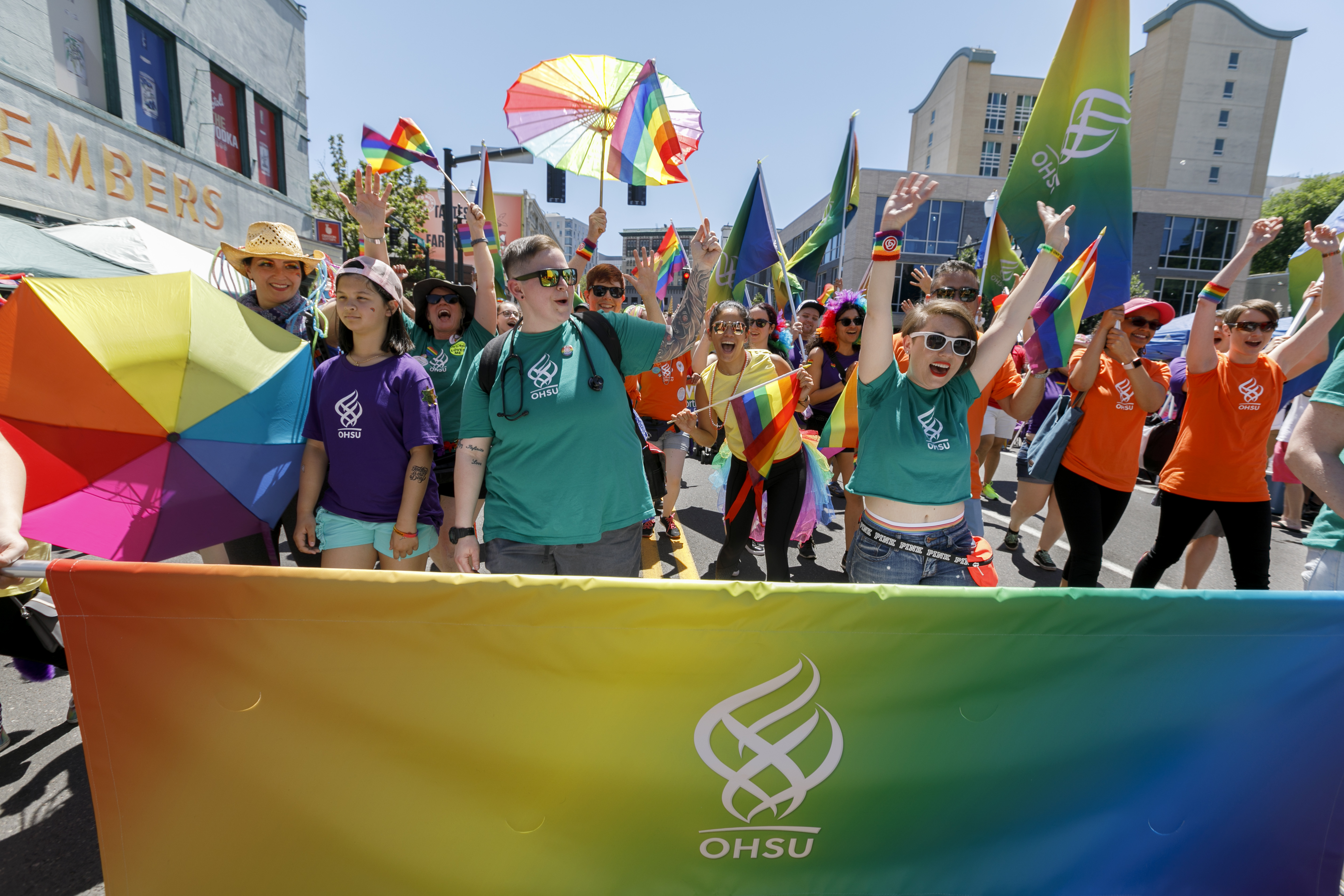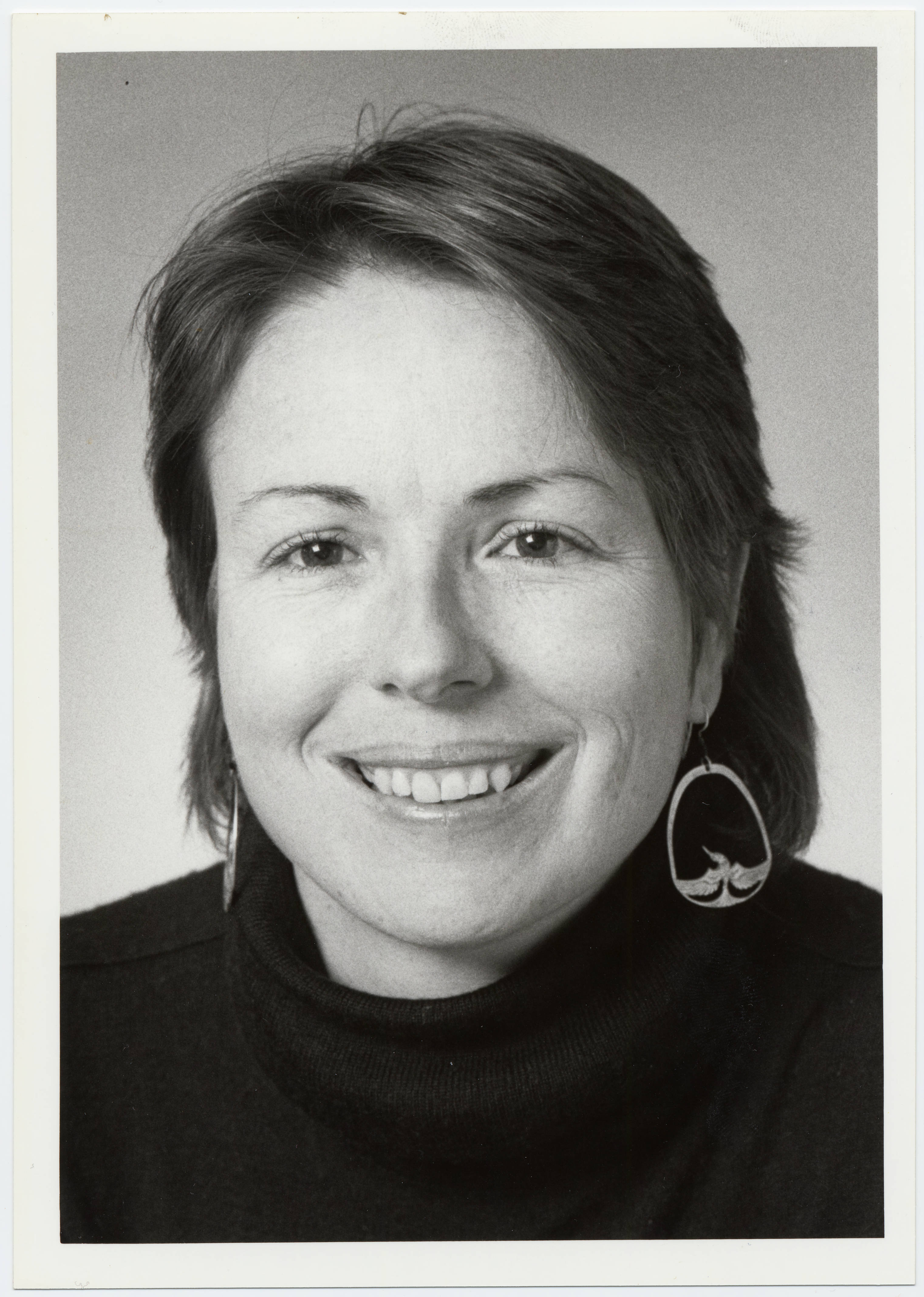Queering OHSU: Honoring Our LGBTQ+ History

Oregon Health & Science University and its predecessor institution, the University of Oregon Medical School, have a long history with LGBTQ+ communities. OHSU has cared for patients, researched potential cures for HIV, supported inclusive employee benefits and treatment, and forged ahead in transgender health. The materials below trace that history through archival documents and highlight the changing nature of that support through the years.
Please be aware that, as history continuously moves forward, and as times and cultures change, the documentary evidence of times past remains static. As such, throughout this exhibit, you may notice terminology that was once popular or appropriate, but is now considered offensive or vulgar. While we do not wish to cause harm in the present, it is important to know our history and see how far we’ve come.
Curated by Steve Duckworth, University Archivist. Last updated June 2021.
TRANSGENDER CARE & COMMUNITY
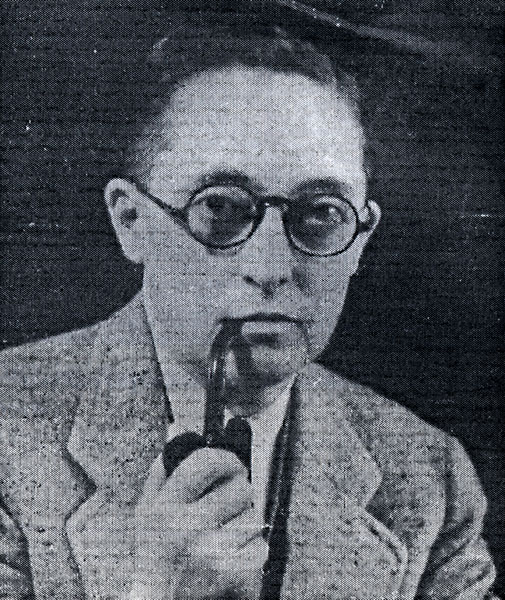
Alan Hart is the first known transgender graduate of the University of Oregon Medical School, and therefore of OHSU. He is one of the first trans men to undergo surgery as part of his transition process. Hart was born in Kansas in 1890 and moved to Oregon after the death of his father in 1892. After attending Albany College (now Lewis & Clark), Hart attended the University of Oregon Medical School, graduating in 1917.
The following year, Hart had a hysterectomy, married his first wife, Inez Stark, and began a medical practice in Gardiner, Oregon. He worked as a radiologist and had a special interest in tuberculosis. Hart frequently had to relocate after being “found out” and in 1923, Stark left him due in part to the stress of these frequent relocations as well as the strain of keeping Hart’s past hidden. He was divorced from Stark by 1925 and married his second wife, Edna Ruddick, the same year. They remained married until Hart’s death in 1962.
J. Allen Gilbert was a psychiatrist at UOMS who worked with Hart as a patient. It was through therapy with Gilbert that Hart made the decision to have a hysterectomy and transition to outwardly living as a man. In 1920, Gilbert published the article, “Homosexuality and its Treatment,” in the Journal of Nervous and Mental Disease, tracing the history of a subject identified only as “H.”1 H, now known to be Hart, came to Gilbert to address a phobia he had suffered from for years, but Gilbert quickly came to the conclusion that “the whole trouble [was] connected in some way with sex.”
The article speaks to Hart’s youth, how he gravitated towards typically male activities and attire, the abuse he suffered from his stepfather, his growing attraction to women, and more. Gilbert and Hart attempted to treat the “difficulty” with hypnosis and other “suggestive therapeutics,” to no avail. Hart then began to worry that a cure might remove him of his “masculine ambitions and tastes” and this is when he began to look at other options. Sometime later, Hart decided on the course, and, as Gilbert writes, “Hysterectomy was performed, [his] hair was cut, a complete male outfit was secured and having previously identified [himself] with the red cross, [he] made [his] exit as a female and started as a male with a new hold on life and ambitions worthy of [his] high degree of intellectuality.”
In addition to his medical career, Hart was also a best-selling author, and his works frequently exhibit autobiographical content. The title character of Doctor Mallory is a country doctor who fights against ignorance and prejudice, and makes an argument for socialized medicine. In The Undaunted, Hart hits even closer to home with gay physician "Sandy Farquhar" who pursues a career in radiology "because he thought it wouldn't matter so much in a laboratory what a man's personality was.”
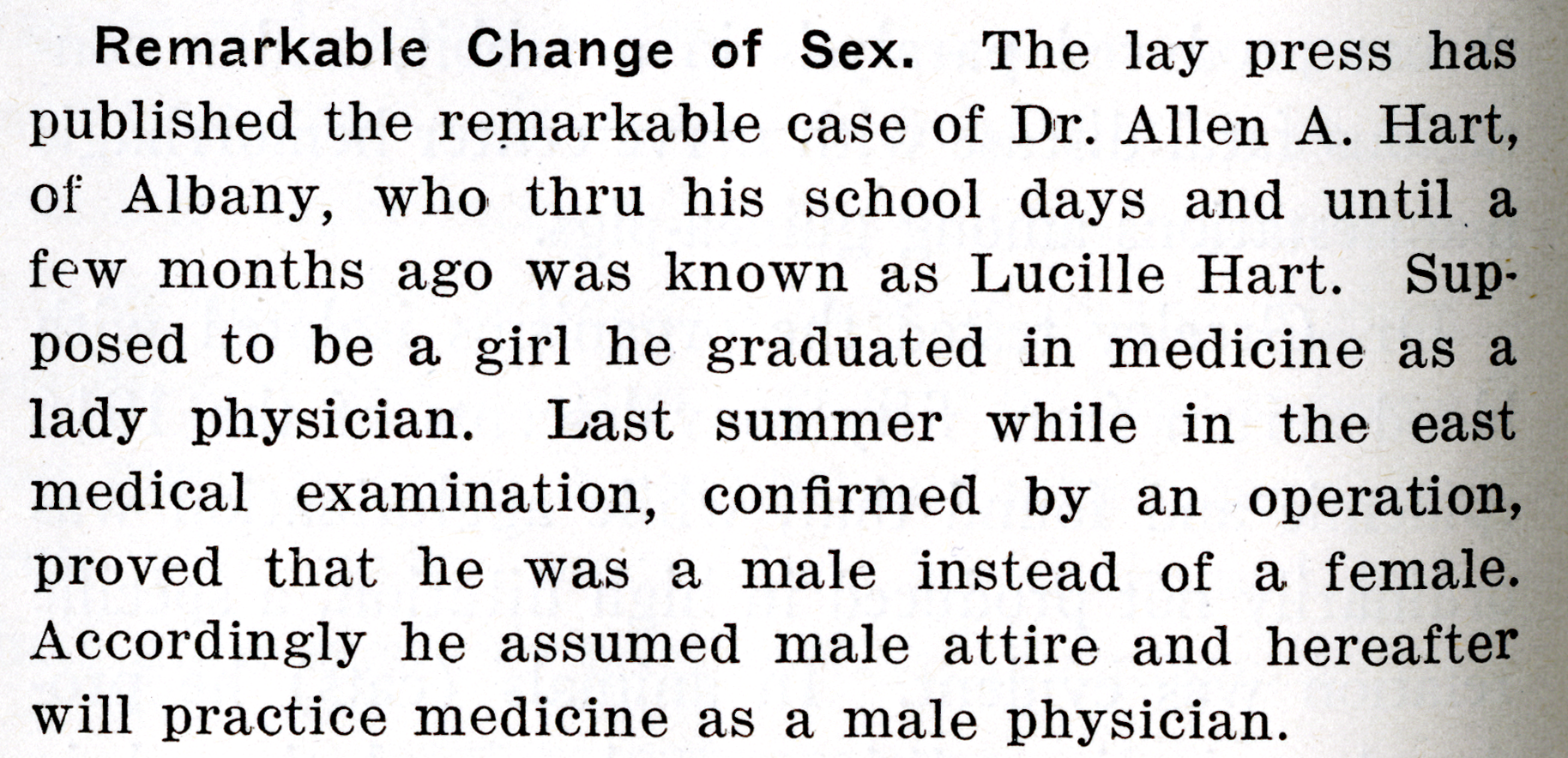
After being outed by a former classmate, notices in various medical journals remark on the curiosity of Hart’s transition without much fanfare.
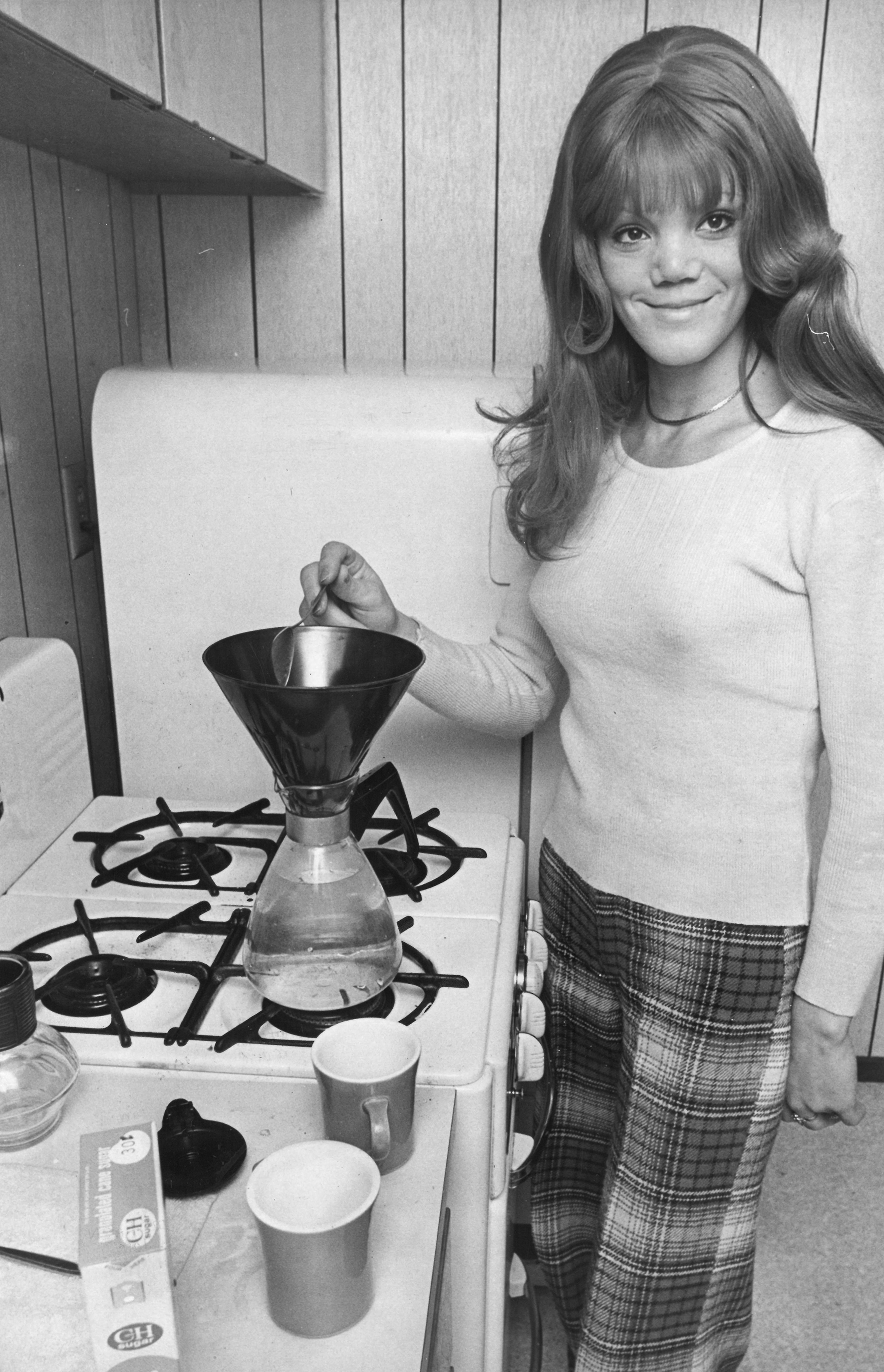
In 1972, the Oregon Journal featured a trans woman named Stephani who was seeking welfare support for her gender affirmation surgery.2 In 1974, the same woman, having had the surgery and now known as Parish, wrote a four-part series of first-person narratives for the Journal – giving a face and a personal story to the many struggles trans people go through to this day. The editors stated they wanted to “contribute to a better understanding of the human” and “medical aspects” of what we currently refer to as gender dysphoria.3
The articles talked about her youth, when her mother took her to Doernbecher Children’s Hospital for psychological testing. She was found to be “normal” and had a high IQ. As a teen, Parish ran away multiple times but eventually landed in Dammasch Mental Hospital.4 At 16, she ran away to San Francisco where she began hormone therapy.5 She later returned to Portland and learned of a doctor at the University of Oregon Medical School who worked with a team focusing on transgender care and gender affirming surgery.6 Dr. Ira Pauly, a psychiatrist, and Dr. Raphael Durfee, a gynecologist, worked as a team to treat patients, however, the surgery was “officially banned” at UOMS even though similar institutions in the area (such as the University of Washington’s Gender Identity Clinic) were routinely performing the operations. Private hospitals and clinics had to be used for the actual surgery.
Though the language used is dated, much of what is conveyed through Parish’s articles still resonates today: “What occurred was an operation …. to bring my body into harmony with my lifelong feelings of gender. I have never considered myself anything but a woman.” “To be more clear, I did not want to be LIKE a woman; I wanted to BE a woman. In my own view, in fact, I really WAS a woman …”7
In her articles, Stephani/Parish mentions supportive doctors at the University of Oregon Medical School conflicting with the schools official opposition to any gender affirming surgery.
One of those supportive medical professionals was Dr. Ira Pauly, a psychiatrist at UOMS who worked with trans patients to help facilitate surgery. Pauly wrote multiple papers focusing on transgender people. In “Male Psychosexual Inversion: Transsexualism: A Review of 100 Cases,” published in the Archives of General Psychiatry in 1965, Pauly reviewed the cases of 100 “biologically male” trans patients from around the world with the goal to clarify both the biological and psychological data.8 This research is credited as the first global review of the published data on transgender patient outcomes. In “Body Image and Gender Identity,” published in the Journal of Sexual Behavior in 1975, Pauly and a student, Thomas Lindgren, developed a body image scale for trans patients that helped quantify a patient’s body and gender dysphoria.9 The scale was one part of a larger set of tools used to evaluate and track patients that were requesting or had already been accepted for treatment. Other aspects of Pauly’s treatment included living for a year as the gender to which patients wished to transition, as well as maintaining psychological counseling.
Many of these tools have remained staples in the typical treatment of trans patients through the following decades, and the body image scale has gone on to be used by cis-gendered patients with body dysmorphia issues as well. In the 1980s, Pauly served as president of the Harry Benjamin International Gender Dysphoria Association, which is now known as the World Professional Association for Transgender Health. His research and work have revolutionized transgender health care.
Toby Meltzer joined OHSU as a clinical professor of plastic surgery in 1990 and began working with transgender patients in 1993. He is known for developing a technique that allowed patients to retain more sensation post-surgery. And today, the OHSU Transgender Health Program “offers comprehensive, lifelong, gender-affirming care” through a team-based approach. They have become a leader in the field and often consult with other medical and health science institutions to help them advance their own care for trans, non-binary, and gender-nonconforming patients.
HIV COMMUNITY OUTREACH & CARE
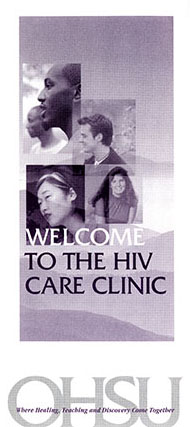
HIV and AIDS disproportionately hit the LGBTQ+ community starting in the 1980s, bringing an epidemic that brought with it the tragic loss of a large segment of the population, and ongoing stigma and emotional trauma. The records in this exhibit review multiple aspects of the epidemic from a historical and OHSU-centered perspective, including outreach, education, healthcare, and research. But these archives are not just history. As of 2020, estimates are that about 38 million people globally are living with HIV, with around a million dying from AIDS-related illnesses each year and about 1.7 million becoming newly infected (UNAIDS). In the United States, gay and bisexual men make up around 57% of the HIV+ population. Over 21% of transgender women are living with HIV, with even higher rates among transgender women of color (CDC and HRC). While HIV/AIDS has never been strictly an LGBTQ+ issue, it has hit these communities hard and continues to shape their lives and their history.
In the 1990s, Dr. Mark Loveless worked to bring more dignity and comfort to HIV+ patients in Oregon with a grant that established OHSU’s Partnership Project. Dr. Loveless also coordinated programs to educate rural healthcare workers about the many issues surrounding HIV and AIDS. Educational initiatives, such as national Condom Week, helped people learn more about AIDS and encouraged the use of condoms as a means of safer sex. Dr. Grover Bagby, Jr. was researching possible ways to stop the effects of AIDS on bone marrow.
In the School of Nursing, Doctors Marie Berger and Caroline White were learning that nurses were hampered in providing quality care by a variety of legal and societal issues, while Barbara Limandri focused her research on gay men and their fears around HIV testing. And the Russell Street Clinic, OHSU’s community dental clinic, was providing compassionate dental care to HIV+ patients from around the state, as many were refused care by their local dentists.
Today, OHSU continues to work towards improving the health of people living with HIV, with programs such as the Partnership Project, which continues to operate over 25 years since it began, and faculty like Dr. Louis Picker, whose research in the Vaccine and Gene Therapy Institute aims to produce a cure for HIV and AIDS.
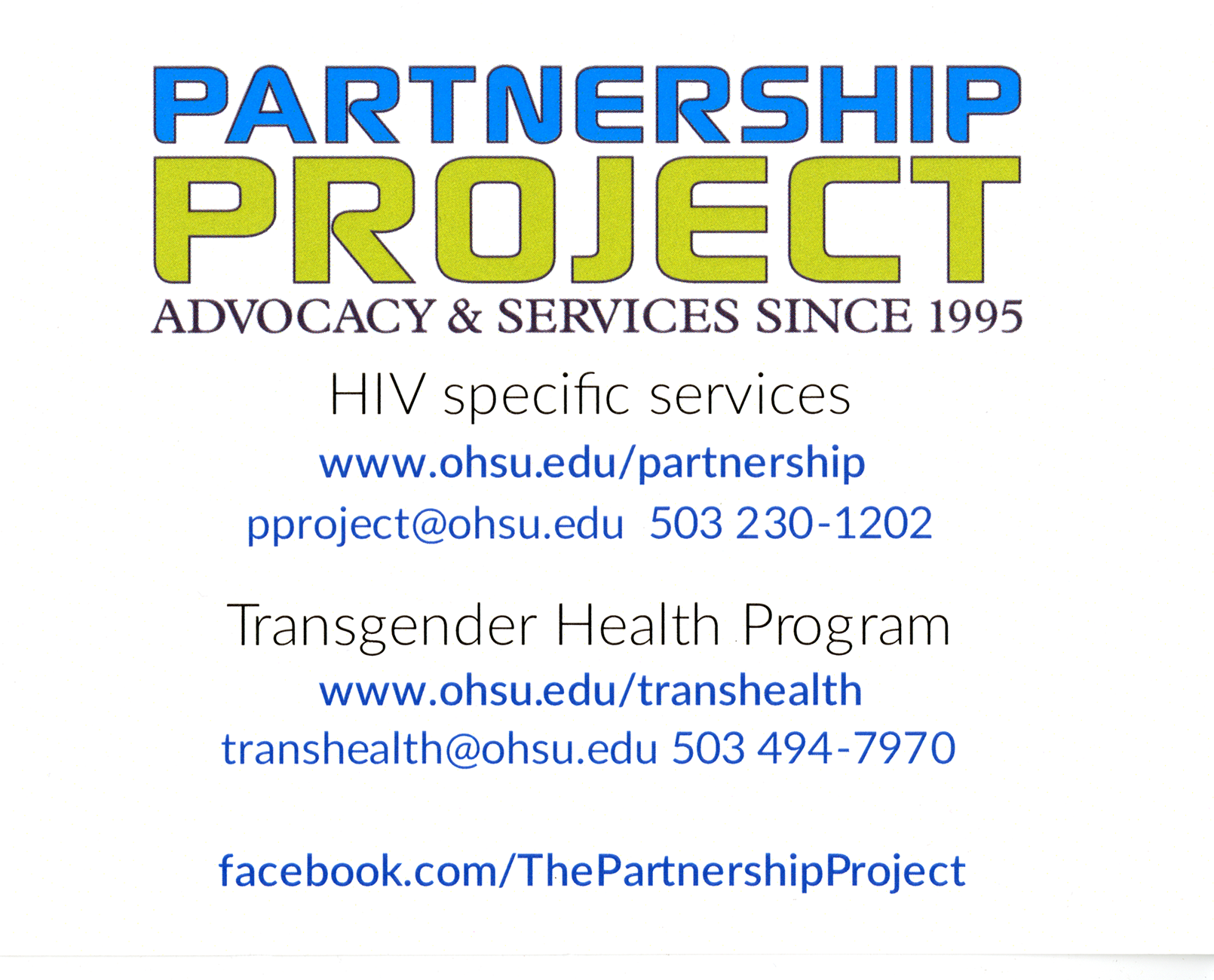
OHSU’s Partnership Project was founded in 1995 to help people living with HIV/AIDS reach the highest quality of life possible for the longest amount of time. The program brought together medical and social services to provide team-based care for their clients, with the aim of meeting their needs in a respectful and individualized way.
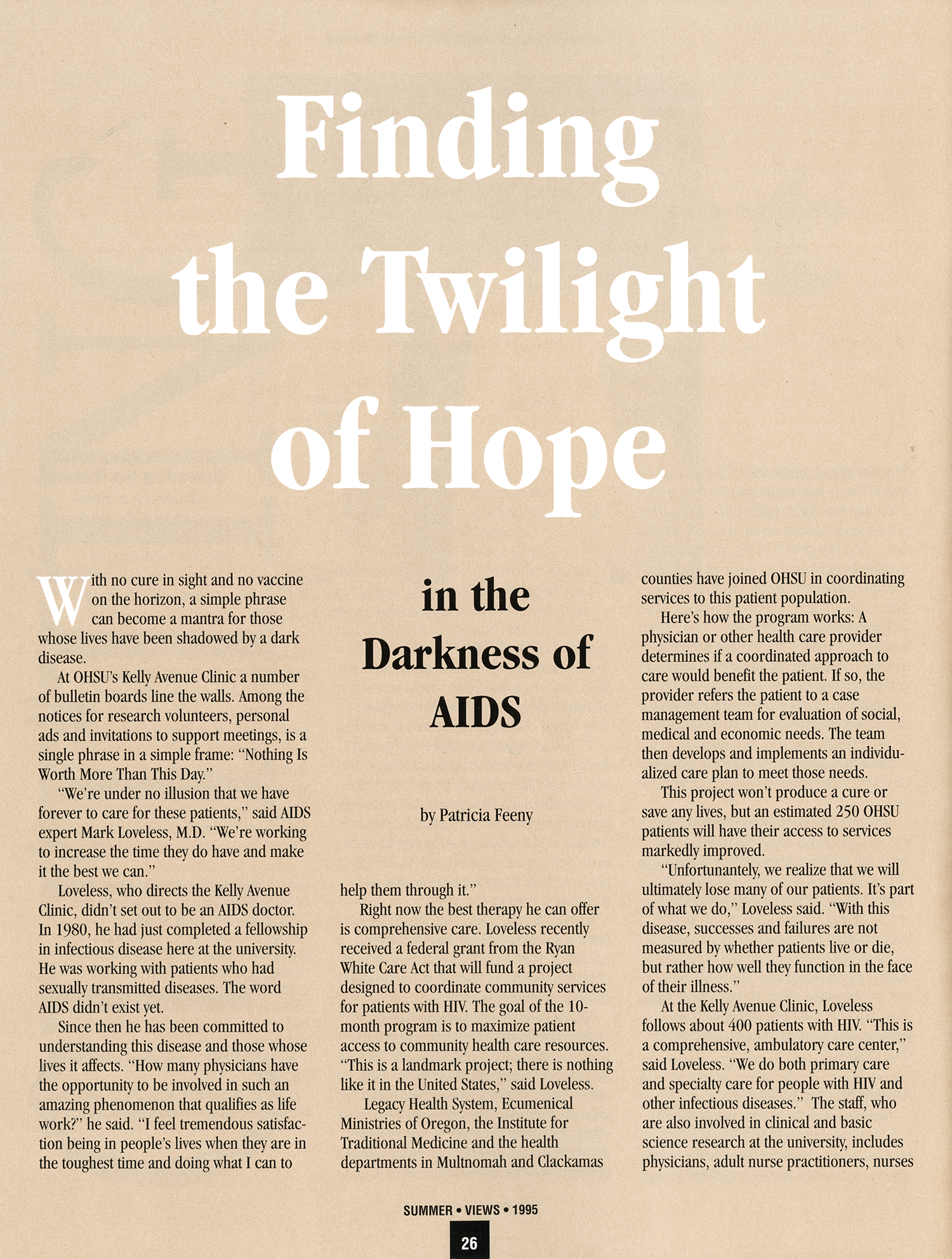
In the 1990s, Dr. Mark Loveless worked to bring more dignity and comfort to HIV+ patients in Oregon. In 1995, he received a grant through the Ryan White Care Act to coordinate community services for patients. The project connected services from OHSU, Legacy Health, Ecumenical Ministries of Oregon, the Institute for Traditional Medicine, and the Multnomah and Clackamas county health departments. The Kelley Avenue clinic, directed by Loveless, served about 400 patients at this time and estimated about 250 would benefit from the improved services brought about by the project. This initiative was dubbed the “Partnership Project” and continues to this day at OHSU.
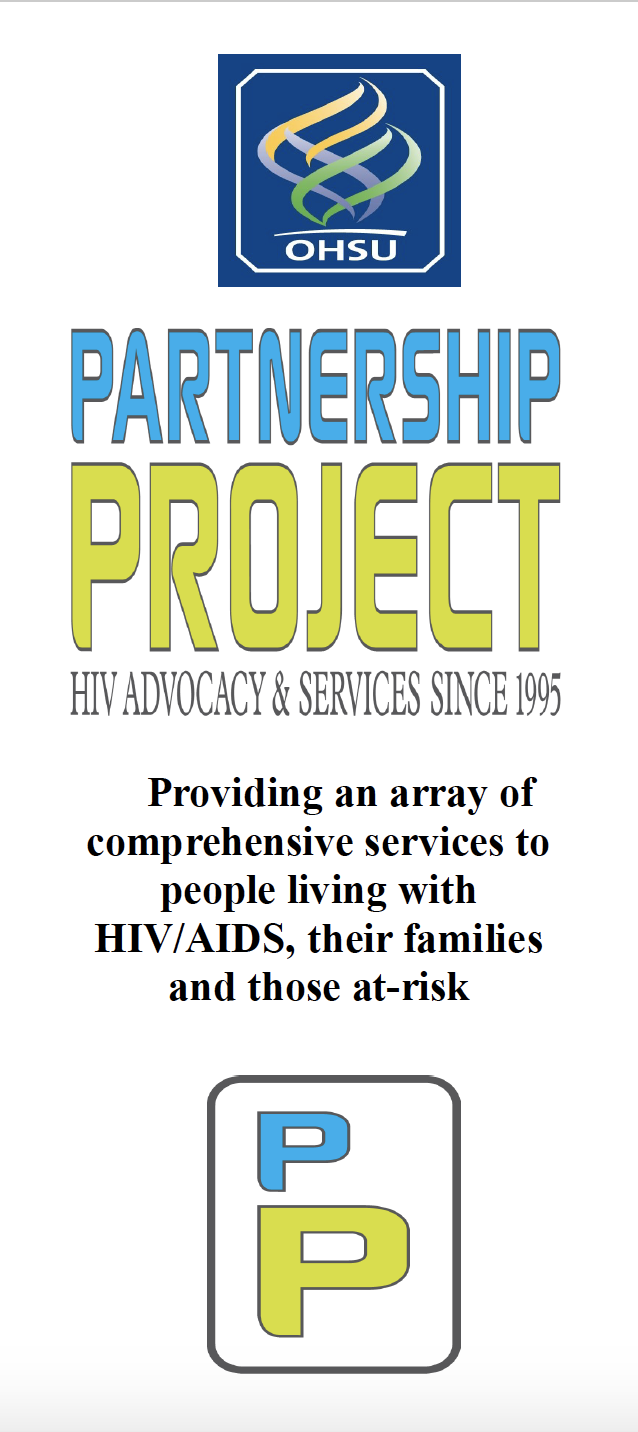
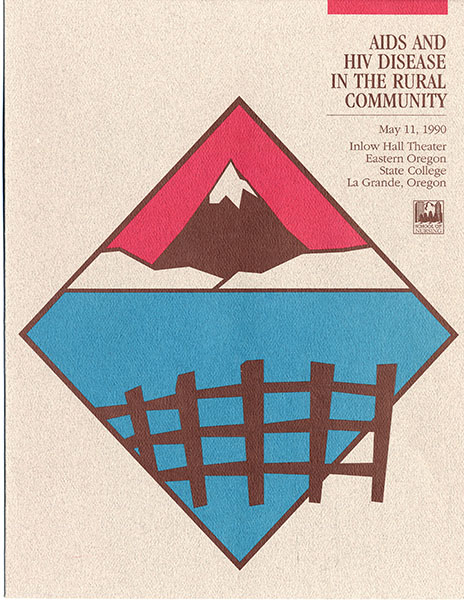
As early as 1990, OHSU was working throughout Oregon to educate healthcare workers about the many issues surrounding HIV and AIDS. This educational symposium, featuring Dr. Mark Loveless and James Simons, R.N.C., from the AIDS Education and Training Center, focused on issues specific to patients living in rural areas. They shared information on current technologies, procedures, and treatment strategies; identified approaches for preventing and managing complications; discussed the emotional impacts of HIV and AIDS on patients; enhanced assessment skills; and helped medical professionals understand the historical response to epidemics.
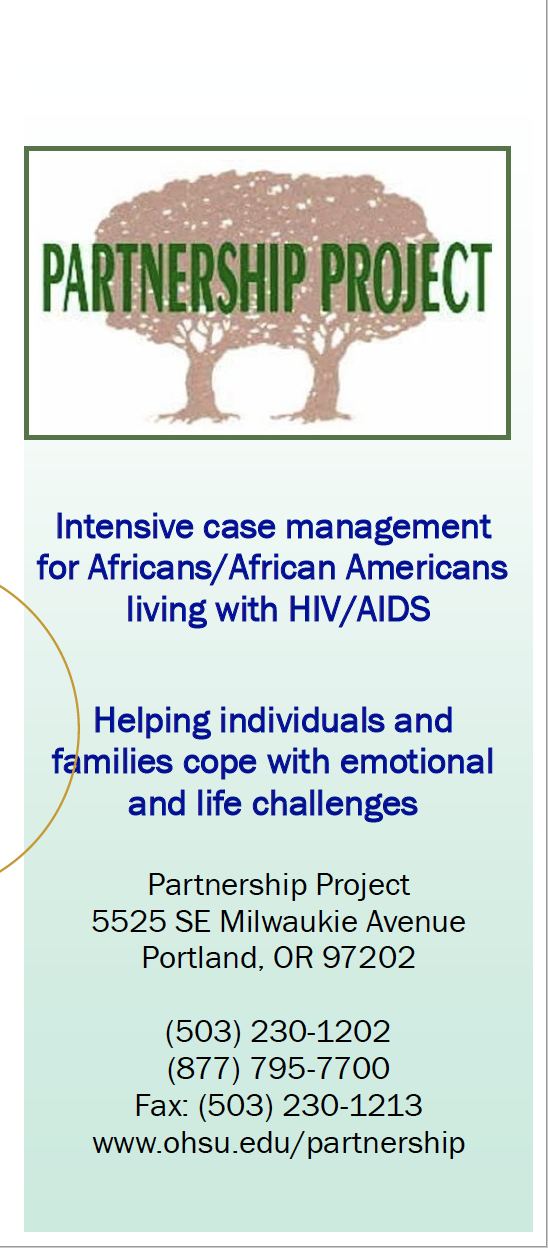
The Partnership Project continues its work today, working with a consortium of 13 different agencies in the Portland area to provide comprehensive, client-centered case management to HIV+ individuals and their families. They collaborate with Lutheran Family Services in the Minority AIDS Initiative, which works to provide intensive and culturally appropriate services to refugees and immigrants living with HIV. They are now also home to OHSU’s Transgender Health Program.
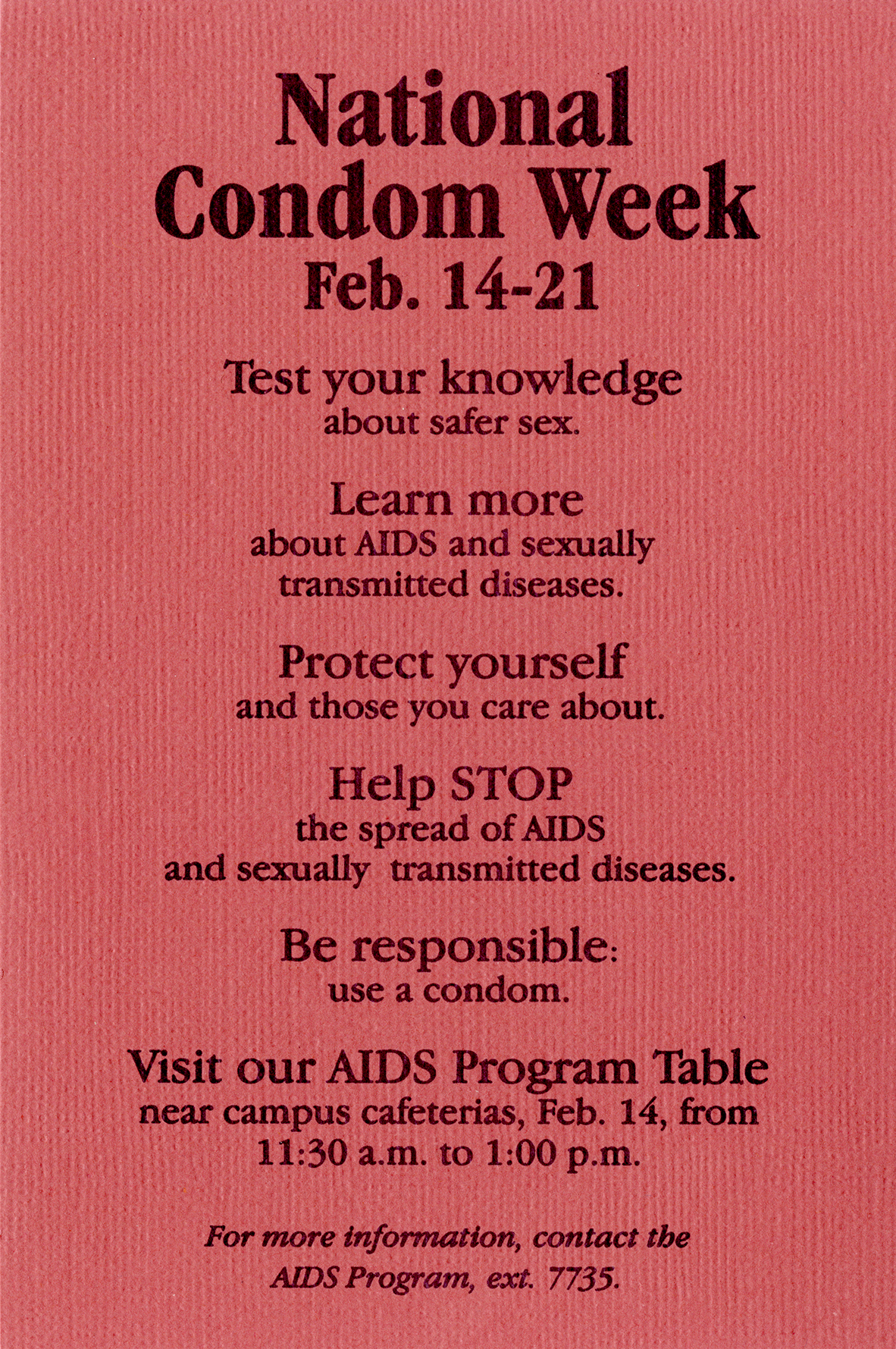
During the 1990s, National Condom Week made its way to OHSU. This week of education focused on sharing information about safer sex, helping people to learn more about AIDS and sexually transmitted diseases, and encouraged the use of condoms as a means of safer sex. National Condom Week was a means to educate the OHSU community about how to stay healthy and raise awareness about HIV.
RUSSELL STREET DENTAL CLINIC
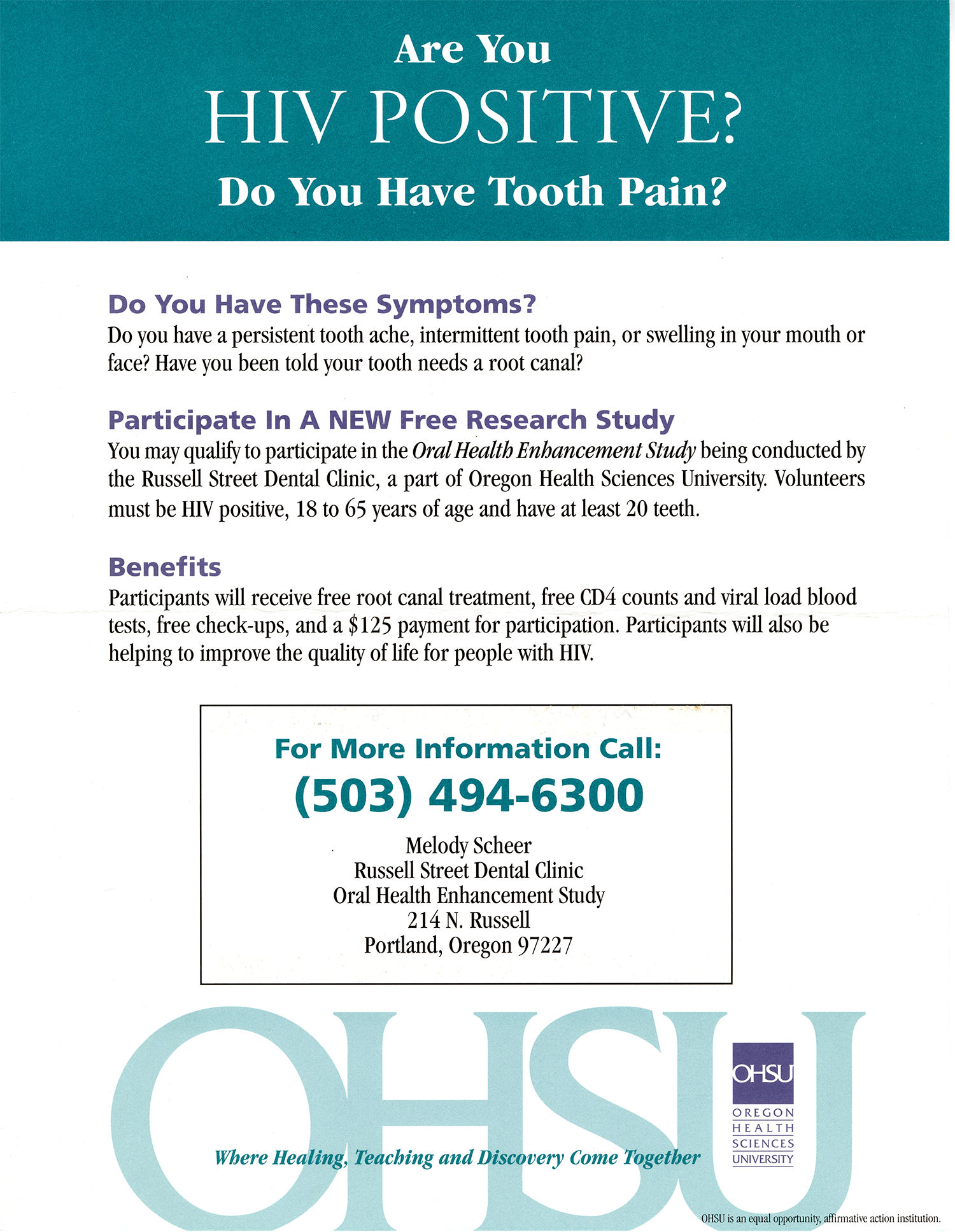
The Russell Street Clinic, OHSU’s community dentistry clinic since 1975, has served as a haven for many in the HIV+ community. Before the virus was well understood, many dentists refused to treat positive patients. Russell Street, headed by Dr. David Rosenstein, made it its mission to never turn away a patient, to make them feel welcome, and to provide them with high quality dental care.
HIV+ patients often experienced dental health complications, such as gum disease. The Russell Street Clinic worked not only to treat HIV+ patients’ symptoms, but to educate patients on HIV and how to keep themselves healthier. In addition to providing care for low income and HIV+ patients, the Russell Street Clinic also offered a free research study which provided participants with a free root canal treatment, viral load blood counts, free check-ups, and compensation for their participation. The Russell Street Clinic was a leader for HIV dental care in Portland.
Oral history interview on the Russell Street Clinic
Dr. Rosenstein didn’t just treat patients’ dental concerns; he knew that quality care included respect for the patient and providing psychological support through compassionate treatment. He traces his ideals on patient care back to his youth, growing up poor with parents both suffering from debilitating medical conditions: his mother had muscular dystrophy and his father had multiple sclerosis. He saw how a lack of money and access to health care affected his family. After graduating from Harvard, he vowed to use his training for the betterment of people that suffered as he and his family did, and to provide high-quality dental care for those who could least afford it. For Rosenstein, embracing HIV+ patients was a natural extension of his core values.
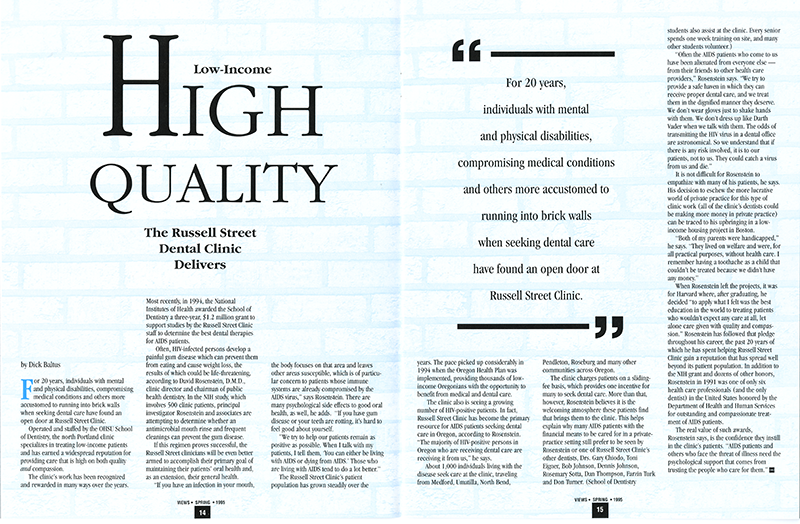
As research on HIV advanced, materials such as the brochure at right on HIV Infection and Oral Health emerged. Materials such as these, geared toward persons who were HIV positive, served to inform patients about dental care, including prevention, the benefits of dental care, what one can expect from a dental visit, and what can be done on one’s own. Materials like these aimed to raise awareness about the relationship between HIV and dental health and to make the information more accessible to patients.
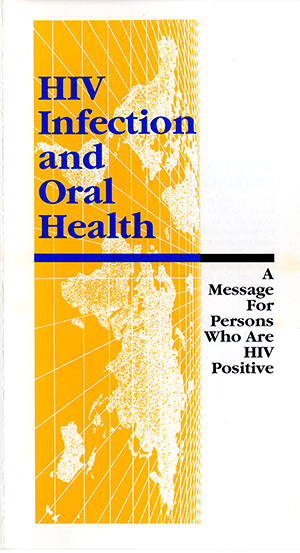
HIV RESEARCH
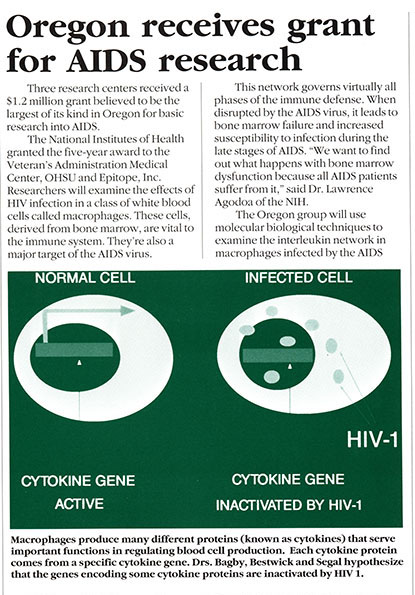
Research into HIV and AIDS was another priority for the institution. In 1989, Dr. Grover Bagby, Jr. and other researchers at OHSU and the Veterans Affairs Medical Center received a sizable grant from the NIH to examine the effects of HIV infection on macrophages, a class of white blood cells. In 1991, researchers in the School of Nursing were focusing on the needs of HIV+ patients. Drs. Marie Berger and Caroline White found that nurses wanted to provide quality care, but were hampered by issues involving confidentiality, reimbursement, lack of resources, and fear (both personal and institutional). On the other side, Barbara Limandri focused her research on patients, specifically gay men and their feelings around HIV testing. She found that many gay men avoided testing until they were almost certain they were HIV+. Men who received negative results often reacted poorly out of distrust for the test, survivor’s guilt, or a hopeless feeling that it was only a matter of time before they did become positive.
HIV/AIDS research continues today at OHSU in such places as the Vaccine and Gene Therapy Institute, in a lab headed up by Dr. Louis Picker. In 2014, Picker received $25 million from the Bill and Melinda Gates Foundation to further his research into a vaccine to cure HIV/AIDS. Studies in monkeys have shown that the vaccine cleared all traces of infection – meaning it could be a cure for those infected with HIV, not just a preventative solution. In 2021, his vaccine entered human trials.
CULTURE
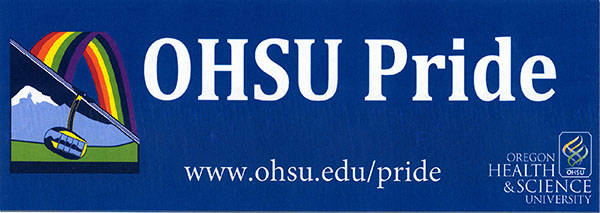
The culture of an organization is a large factor in how it is regarded and remembered; it influences staff retention and public reputation. From the LGBTQ+ employee resource group and overarching diversity focus, to more inclusive employee benefits, OHSU is making strides to live up to its vision to be "diverse in people."
In 2007, students, faculty, and staff began meeting in order to create an organization for LGBTQ+ members of the OHSU community. Out of this group, the Coalition for the Health and Affirmation of Sexual Minorities (CHASM) was formed. The group participated in and sponsored various events and initiatives through the years, including an annual food drive and an annual LGBTQ+ film festival held in the OHSU Auditorium. OHSU officially participated in its first Portland Pride Parade in 2010 as a collaboration between CHASM and the Cultural Advocacy Team. In 2011, CHASM transitioned from being an affinity group to being an Employee Resource Group, and changed its name to OHSU Pride. Pride continues to foster an inclusive environment that promotes LGBTQ+ wellness, education, research and advocacy within and across OHSU and the community.
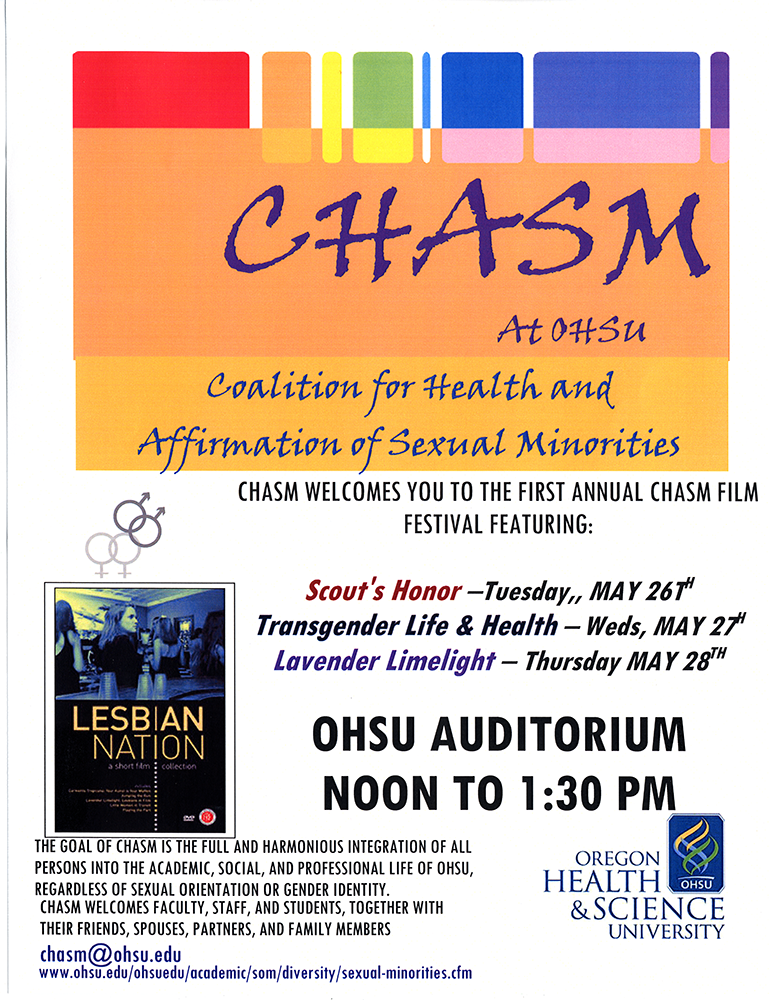
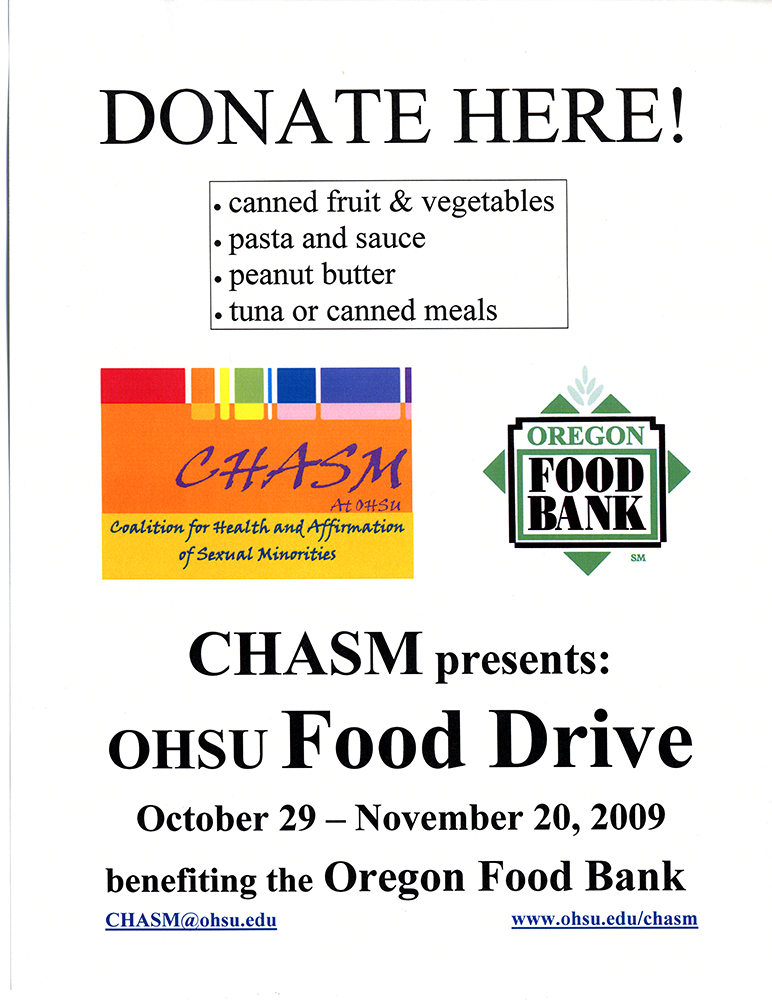
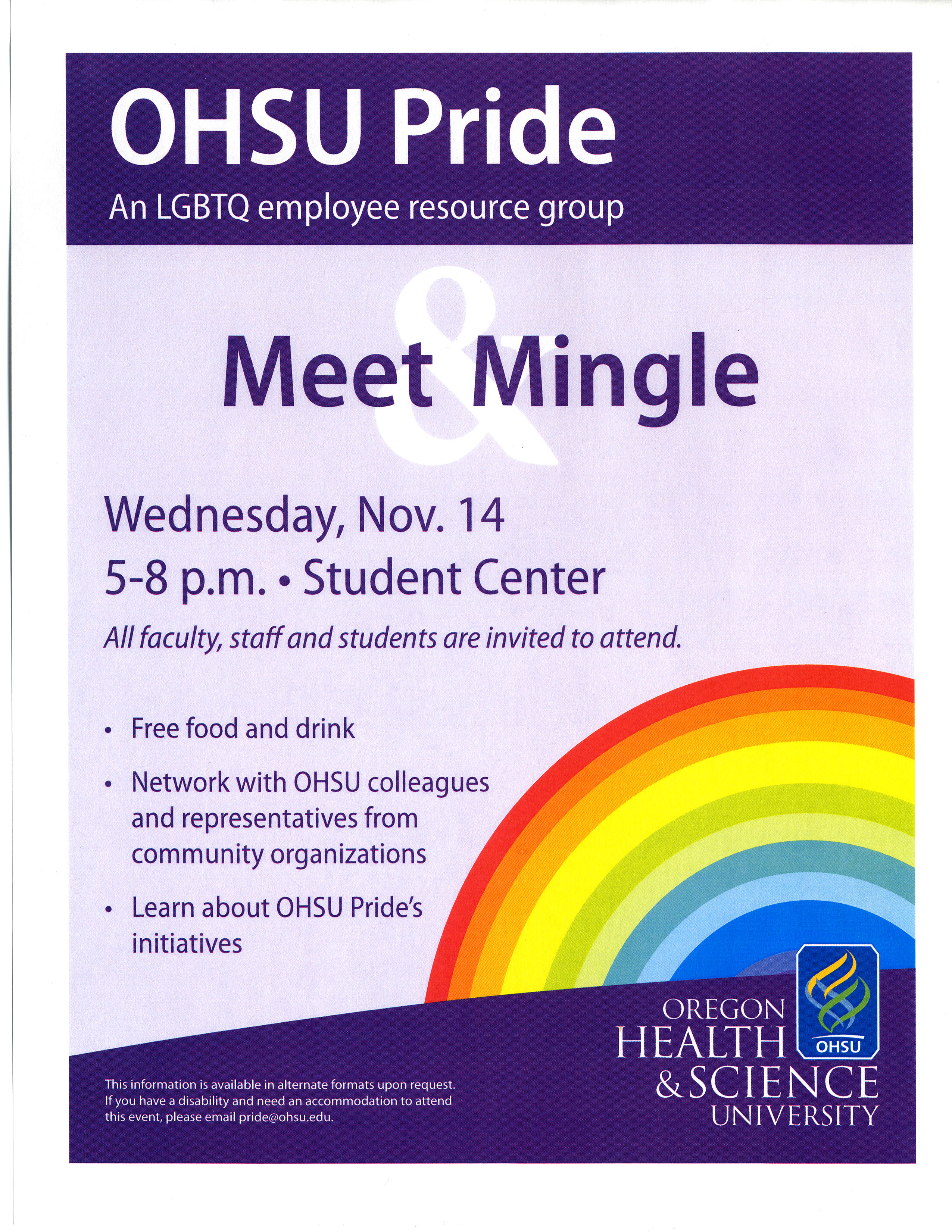
Dr. Christine Tanner joined the School of Nursing in 1979 and served in many roles during her career there, including as Interim Dean of the school. Around 1995, Tanner became the lead plaintiff in a case against OHSU regarding domestic partner benefits. OHSU denied benefits to unmarried couples, yet, at the time, same-sex marriage wasn’t legal in Oregon. In 1995, the court ruled in favor of Tanner and the other plaintiffs, stating that OHSU could not deny group insurance benefits to unmarried domestic partners. The ruling was upheld on appeal. Though OHSU had begun offering domestic partner benefits before the 1995 ruling, the appellate decision guaranteed that those benefits couldn’t be taken away. Moreover, the ruling also paved the way for something unexpected: when Multnomah County decided that refusing marriage licenses to same-sex partners was discriminatory, the courts cited the Tanner decision as a basis. Tanner was influential in bringing both partner benefits and same-sex marriage to the state of Oregon.
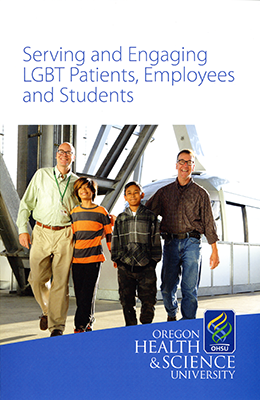
In 2011, OHSU was named a “Leader in LGBT Healthcare Equality” by the Human Rights Campaign in the Healthcare Equality Index. The index began in 2007 and OHSU worked to meet the benchmarks by aligning the language of policies with practices already in place aided by a cross-mission committee. The criteria included inclusive policies for employees, patients and visitors, and training for employees in compassionate care. OHSU continued its inclusion efforts in 2012 when it extended employee health care coverage to include gender transition services, as well as to cover costs of other related treatments.10
The Center for Diversity and Inclusion leads and supports university-wide initiatives to create an environment of respect and inclusion for all people. They offer a range of resources and services to encourage and empower students, faculty and staff from all walks of life. Their services are available to patients, students and employees alike.
Records in this exhibit represent OHSU’s LGBTQ+ history as recorded in the University’s Historical Collections & Archives. If you have records related to this history that you’d like to add to the archives, please contact Steve Duckworth, University Archivist.
Exhibit text and selections by Steve Duckworth. Editorial contributions by Meg Langford, Roman Block, and Zoë Maughan.
Notes
1 J. Allen Gilbert, “Homosexuality and its Treatment,” Journal of Nervous and Mental Disease, 52(4), 1920: 297-322.
2 Parish, “Portlander Asks Sex Change Surgery.” Oregon Journal (Portland, Oregon), September 25, 1972: 4. NewsBank: Access World News – Historical and Current.
3 Parish, "A Boy Made of 'Sugar and Spice'." Oregon Journal (Portland, Oregon), March 18, 1974: 15. NewsBank: Access World News – Historical and Current.
4 Parish, "Hustle and Bustle of Big City Mostly Hustle for Parish, But Finally She Lives as a Girl." Oregon Journal (Portland, Oregon), March 19, 1974: 22. NewsBank: Access World News – Historical and Current.
5 Parish, "Parish Decides Being Topless Waitress Not Her Dish; She Tries 'Married' Life." Oregon Journal (Portland, Oregon), March 20, 1974: 43. NewsBank: Access World News – Historical and Current.
6 Parish, "Surgery is 'Rebirth' for Parish; Starts Her New Life." Oregon Journal (Portland, Oregon), March 21, 1974: 17. NewsBank: Access World News – Historical and Current.
7 Parish, "A Boy Made of 'Sugar and Spice'."
8 Ira B. Pauly, “Male Psychosexual Inversion: Transsexualism: A Review of 100 Cases.” Archives of General Psychiatry, 13(2), 1965: 172–181.
9 Ira B. Pauly & Thomas W. Lindgren, “Body Image and Gender Identity.” Journal of Sexual Behavior, 4(6), 1975: 639-656.
10 “OHSU Extends Coverage to Transgender Workers,” Portland Business Journal, December 17, 2012.
